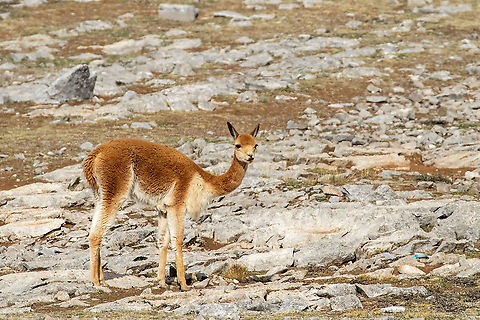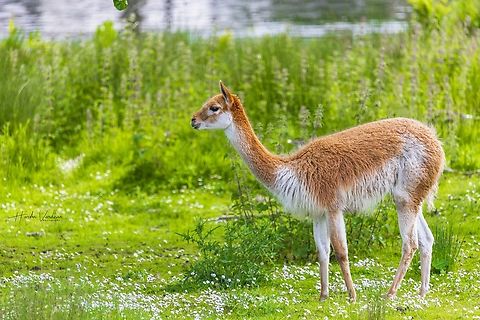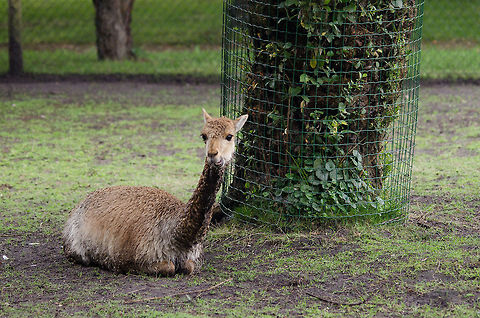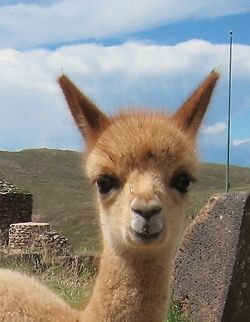
Appearance
The vicuña is considered more delicate and graceful than the guanaco, and smaller. A key distinguishing element of morphology is the better developed incisor roots for the guanaco. The vicuña's long, woolly coat is tawny brown on the back, whereas the hair on the throat and chest is white and quite long.The head is slightly shorter than the guanaco's and the ears are slightly longer. The length of head and body ranges from 1.45 to 1.60 m; shoulder height from 75 to 85 cm; weight from 35 to 65 kg.
To prevent poaching, a round up is held every year, and all vicuñas with fur longer than 2.5 cm are shorn.

Distribution
Vicuñas live exclusively in South America, primarily in the central Andes. They are native to Peru, northwestern Argentina, Bolivia, and northern Chile, with a smaller, introduced population in central Ecuador. Peru has the largest number.
Status
From the period of Spanish conquest to 1964, hunting of the vicuña was unrestricted, which reduced its numbers to only 6,000 in the 1960s. As a result, the species was declared endangered in 1974, and its status prohibited the trade of vicuña wool.In Peru, during 1964–1966, the Servicio Forestal y de Caza in cooperation with the US Peace Corps, Nature Conservancy, World Wildlife Fund, and the National Agrarian University of La Molina established a nature conservatory for the vicuña called the Pampa Galeras – Barbara D'Achille in Lucanas Province, Ayacucho.
During that time, a game warden academy was held in Nazca, where eight men from Peru and six from Bolivia were trained to protect the vicuña from poaching. The estimated population in Peru increased from 6,000 to 75,000 with protection by game wardens. Currently, the community of Lucanas conducts a Chaccu on the reserve each year to harvest the wool, organized by the National Council for South-American Camelids.

Behavior
The behavior of vicuñas is similar to that of the guanacos. They are very shy animals, and are easily aroused by intruders, due, among other things, to their extraordinary hearing. Like the guanacos, they will frequently lick calcareous stones and rocks, which are rich in salt, and will also drink salt water. Their diets consist mainly of low grasses which grow in clumps on the ground.Vicuñas live in family-based groups made up of a male, five to 15 females, and their young. Each group has its own territory of about 18 km2, which can fluctuate depending on the availability of food.
Mating usually occurs in March–April, and after a gestation period of about 11 months, the female gives birth to a single fawn, which is nursed for about 10 months. The fawn becomes independent at about 12 to 18 months old. Young males will form bachelor groups and the young females search for a sorority to join. Along with preventing intraspecific competition, this also prevents in endangered species as observed with cheetahs.
Habitat
Vicuñas live at altitudes of 3,200 to 4,800 m. They feed in daytime on the grassy plains of the Andes Mountains, but spend the nights on the slopes. In these areas, only nutrient-poor, tough, bunch grasses and "Festuca" grow. The sun's rays are able to penetrate the thin atmosphere, producing relatively warm temperatures during the day; however, the temperatures drop to freezing at night. The vicuña's thick but soft coat is a special adaptation which traps layers of warm air close to its body, so it can tolerate freezing temperatures.References:
Some text fragments are auto parsed from Wikipedia.